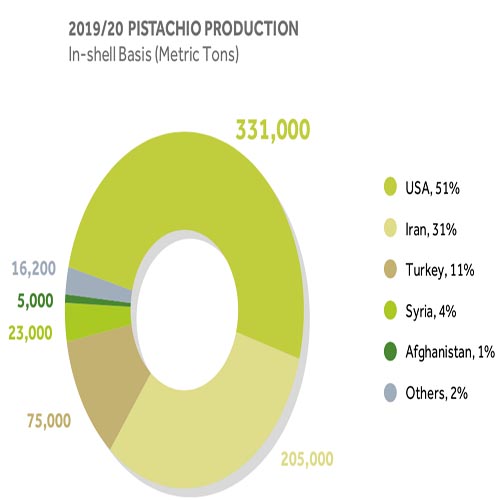The pistachio , a member of the cashew family, is a small tree originating from Central Asia and the Middle East. The tree produces seeds that are widely consumed as food.
Pistacia vera often is confused with other species in the genus Pistacia that are also known as pistachio. These other species can be distinguished by their geographic distributions (in the wild) and their seeds which are much smaller and have a soft shell.
.As of 2017, Iran accounted for over half the world’s production of pistachio
The pistachio tree is native to regions of Central Asia, including present-day Iran and Afghanistan.Archaeology shows that pistachio seeds were a common food as early as 6750 BCE.The modern pistachio P. vera was first cultivated in Bronze Age Central Asia, where the earliest example is from Djarkutan, modern Uzbekistan.
It appears in Dioscorides’ writings as pistakia (πιστάκια), recognizable as P. vera by its comparison to pine nuts. Pliny the Elder writes in his Natural History that pistacia, “well known among us”, was one of the trees unique to Syria, and that the seed was introduced into Italy by the Roman Proconsul in Syria, Lucius Vitellius the Elder (in office in 35 CE) and into Hispania at the same time by Flaccus Pompeius. The early sixth-century manuscript De observatione ciborum (“On the observance of foods”) by Anthimus implies that pistacia remained well known in Europe in Late Antiquity. Archaeologists have found evidence from excavations at Jarmo in northeastern Iraq for the consumption of Atlantic pistachio. The Hanging Gardens of Babylon were said to have contained pistachio trees during the reign of King Merodach-Baladan about 700 BCE
:Characteristic
The tree grows up to 10 m (33 ft) tall. It has deciduous pinnate leaves 10–20 centimeters (4–8 inches) long. The plants are dioecious, with separate male and female trees. The flowers are apetalous and unisexual and borne in panicles.
The fruit is a drupe, containing an elongated seed, which is the edible portion. The seed, commonly thought of as a nut, is a culinary nut, not a botanical nut. The fruit has a hard, cream-colored exterior shell. The seed has a mauve-colored skin and light green flesh, with a distinctive flavor. When the fruit ripens, the shell changes from green to an autumnal yellow/red and abruptly splits partly open. This is known as dehiscence, and happens with an audible pop. The splitting open is a trait that has been selected by humans.Commercial cultivars vary in how consistently they split open.
The pistachio tree is long-lived, possibly up to 300 years.The trees are planted in orchards, and take approximately seven to ten years to reach significant production. Production is alternate-bearing or biennial-bearing, meaning the harvest is heavier in alternate years. Peak production is reached around 20 years. Trees are usually pruned to size to make the harvest easier. One male tree produces enough pollen for eight to twelve drupe-bearing females. Harvesting in the United States and in Greece is often accomplished using equipment to shake the drupes off the tree. After hulling and drying, pistachios are sorted according to open-mouth and closed-mouth shells, then roasted or processed by special machines to produce pistachio kernels.
In California, almost all female pistachio trees are the cultivar ‘Kerman’. A scion from a mature female ‘Kerman’ is grafted onto a one-year-old rootstock.
Each pistachio tree averages around 50 kilograms (110 lb) of seeds, or around 50,000, every two years.
The shell of the pistachio is naturally a beige color, but it is sometimes dyed red or green in commercial pistachios. Originally, dye was applied by importers to hide stains on the shells caused when the seeds were picked by hand.Most pistachios are now picked by machine and the shells remain unstained, making dyeing unnecessary except to meet ingrained consumer expectations.
In the 19th century, the pistachio was cultivated commercially in parts of the English-speaking world, such as Australia along with New Mexico and California where it was introduced in 1854 as a garden tree. In 1904 and 1905, David Fairchild of the United States Department of Agriculture introduced hardier cultivars to California collected from China, but it was not promoted as a commercial crop until 1929. Walter T. Swingle’s pistachios from Syria had already fruited well at Niles, California, by 1917
In 2018, the global production of pistachios was about 1.4 million tonnes, with Iran and the United States as leading producers, together accounting for 72% of the total (table). Secondary producers were Turkey, China and Syria
A 2020 report indicated that nearly half of the global production of pistachios in 2019 came from the United States, with production in Iran falling to as low as 7% due to US trade sanctions against Iran, climate change, and weak economic and water management in Iran. Efforts to grow pistachios for international markets were made during 2019 in Georgia and adjacent Caucasus countries.
Raw pistachios are 4% water, 45% fat, 28% carbohydrates, and 20% protein (table). In a 100 gram reference amount, pistachios provide 562 calories and are a rich source (20% or more of the Daily Value or DV) of protein, dietary fiber, several dietary minerals, and the B vitamins, thiamin (76% DV) and vitamin B6 (131% DV) (table). Pistachios are a moderate source (10–19% DV) of calcium, riboflavin, vitamin B5, folate, vitamin E, and vitamin K (table).
The fat profile of raw pistachios consists of saturated fats, monounsaturated fats and polyunsaturated fats.Saturated fatty acids include palmitic acid (10% of total) and stearic acid (2%). Oleic acid is the most common monounsaturated fatty acid (51% of total fat) and linoleic acid, a polyunsaturated fatty acid, is 31% of total fat. Relative to other tree nuts, pistachios have a lower amount of fat and calories but higher amounts of potassium, vitamin K, γ-tocopherol, and certain phytochemicals such as carotenoids, and phytosterols.
All types of persian pistachio:

World’s Tops Pistachio Producer/Exports:







